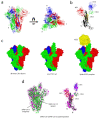Structural Evaluation of the Spike Glycoprotein Variants on SARS-CoV-2 Transmission and Immune Evasion
- PMID: 34299045
- PMCID: PMC8306177
- DOI: 10.3390/ijms22147425
Structural Evaluation of the Spike Glycoprotein Variants on SARS-CoV-2 Transmission and Immune Evasion
Abstract
The emergence of severe acute respiratory syndrome coronavirus 2 (SARS-CoV-2) presents significant social, economic and political challenges worldwide. SARS-CoV-2 has caused over 3.5 million deaths since late 2019. Mutations in the spike (S) glycoprotein are of particular concern because it harbours the domain which recognises the angiotensin-converting enzyme 2 (ACE2) receptor and is the target for neutralising antibodies. Mutations in the S protein may induce alterations in the surface spike structures, changing the conformational B-cell epitopes and leading to a potential reduction in vaccine efficacy. Here, we summarise how the more important variants of SARS-CoV-2, which include cluster 5, lineages B.1.1.7 (Alpha variant), B.1.351 (Beta), P.1 (B.1.1.28/Gamma), B.1.427/B.1.429 (Epsilon), B.1.526 (Iota) and B.1.617.2 (Delta) confer mutations in their respective spike proteins which enhance viral fitness by improving binding affinity to the ACE2 receptor and lead to an increase in infectivity and transmission. We further discuss how these spike protein mutations provide resistance against immune responses, either acquired naturally or induced by vaccination. This information will be valuable in guiding the development of vaccines and other therapeutics for protection against the ongoing coronavirus disease 2019 (COVID-19) pandemic.
Keywords: COVID-19; SARS-CoV-2; immune evasion; spike mutations; spike variants; transmission.
Conflict of interest statement
The authors declare no conflict of interest.
Figures







References
-
- WHO WHO Director-General’s Opening Remarks at the Media Briefing on COVID-19—11 March 2020. [(accessed on 1 January 2021)];2020 Available online: https://www.who.int/director-general/speeches/detail/who-director-genera....
-
- CDC Symptoms of Coronavirus|CDC. [(accessed on 14 March 2021)];2021 Available online: https://www.cdc.gov/coronavirus/2019-ncov/symptoms-testing/symptoms.html.
Publication types
MeSH terms
Substances
Grants and funding
LinkOut - more resources
Full Text Sources
Medical
Miscellaneous

